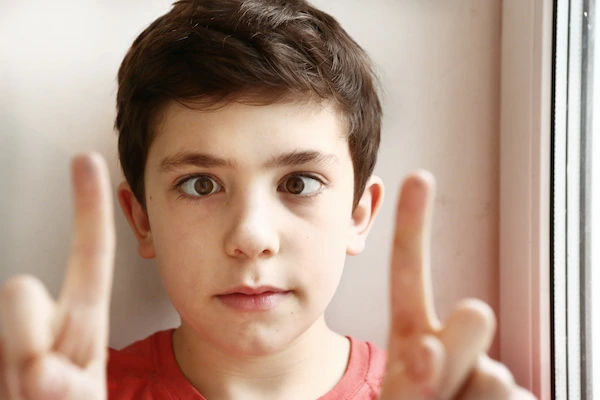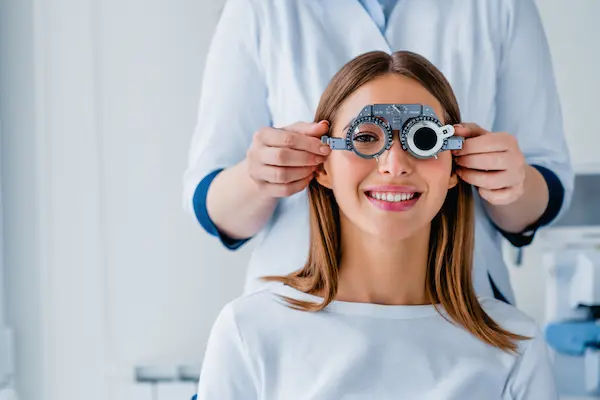Don't Be In The Dark About Squint: A Complete Guide
Learn about squint, its causes, symptoms, and treatment options in this comprehensive guide to better eye health.

Written by Dr. M L Ezhilarasan
Reviewed by Dr. Dhankecha Mayank Dineshbhai MBBS
Last updated on 24th Sep, 2025

Introduction
Have you ever noticed someone whose eyes seem to point in slightly different directions? Or perhaps you've seen a child or even an adult with a misaligned gaze and wondered what it means? This condition, commonly known as a squint or medically termed strabismus, is far more than a simple cosmetic concern. Many people remain in the dark about its causes, implications, and the crucial importance of early intervention. A squint occurs when the eyes do not align properly and point in different directions, preventing them from working together as a team. This can lead to a host of vision problems, including double vision and, in children, a condition called lazy eye (amblyopia). This guide will illuminate everything you need to know about squint, from identifying the early signs and understanding the root causes to exploring the most effective treatment options available today. Knowledge is power, and being informed is the first step toward preserving healthy vision for yourself or your loved ones.
What Exactly is a Squint (Strabismus)?
A squint, known in the medical world as strabismus, is a condition characterised by a misalignment of the eyes. Instead of both eyes focusing on the same object simultaneously, one eye looks directly at the object while the other turns in a different direction inward, outward, upward, or downward. This misalignment can be constant or intermittent, happening only when a person is tired, ill, or focusing on a nearby object.
The human visual system is a complex partnership between the eyes and the brain. Normally, each eye sends a slightly different image to the brain. The brain then fuses these two images into a single, three-dimensional picture, giving us depth perception (stereopsis). When a squint is present, the brain receives two vastly different images. To avoid confusion and double vision (diplopia), the brain may learn to ignore the input from the misaligned eye. This is an adaptive response, but it has a significant downside: it can lead to a permanent reduction of vision in that eye, a condition known as amblyopia or lazy eye.
Different Types of Squint
Squints are categorised based on the direction of the misalignment and how frequently it occurs. Understanding the type is key to diagnosis and treatment.
By Direction of Turn:
- Esotropia: This is the most common type, especially in children. It involves one eye turning inward toward the nose. It can be congenital (present at birth) or develop later.
- Exotropia: This involves one eye turning outward, away from the nose. It is often intermittent, becoming more noticeable when a child is daydreaming, tired, or looking at distant objects.
- Hypertropia: This is a less common type where one eye turns upward.
- Hypotropia: This involves one eye turning downward.
By Frequency:
- Constant Squint: The misalignment is present all the time.
- Intermittent Squint: The misalignment comes and goes. The eyes are aligned some of the time but drift out of alignment under certain conditions.
Consult an Ophthalmologist for the best advice
Common Causes and Risk Factors
The misalignment in strabismus is caused by a failure of the eye muscles to work together. The exact reason for this failure can vary.
- Muscle Imbalance: The most straightforward cause is an imbalance in the muscles that control eye movement.
- Refractive Errors: Uncorrected farsightedness (hyperopia) can cause a child to over-focus their eyes to see clearly, which can trigger an inward turn (accommodative esotropia).
- Nerve Damage: Problems with the nerves that transmit signals to the eye muscles can cause paralysis or weakness, leading to misalignment.
- Genetics: Squint often runs in families, so having a close relative with the condition is a significant risk factor.
- Underlying Health Conditions: Conditions like cerebral palsy, Down syndrome, hydrocephalus, brain tumors, or strokes can affect nerve and muscle control, leading to a squint.
- Premature Birth: Babies born prematurely are at a higher risk for developing squint.
Recognising the Symptoms: Don't Ignore the Signs
Early detection is paramount. Key symptoms to watch for include:
- An obvious misalignment of the eyes. This is the most recognisable sign.
- Tilting the head or turning the face to use both eyes together.
- Squinting or closing one eye in bright sunlight or while focusing.
- Frequent blinking or eye rubbing.
- Double vision.
- Poor depth perception, leading to clumsiness or difficulty with tasks like catching a ball.
- Eyes that do not move together when following an object.
In very young children who cannot verbalise their vision problems, observing their behavior is crucial.
The Critical Link Between Squint and Lazy Eye (Amblyopia)
This is perhaps the most important reason not to ignore a squint. In children under the age of 7-9, their visual system is still developing and is highly "plastic." When the brain ignores the image from the misaligned eye to avoid double vision, the neural pathways from that eye to the brain fail to develop properly. Over time, even if the eye itself is perfectly healthy, the brain's ability to see from it deteriorates, leading to permanently blurry vision; this is amblyopia.
Treating the squint early is essential to force the brain to use both eyes equally and prevent this permanent visual loss. If you suspect a misalignment in your child's eyes, consult a paediatric ophthalmologist immediately. Early assessment can prevent lifelong vision impairment.
How is a Squint Diagnosed?
A comprehensive eye examination is necessary for diagnosis. An optometrist or ophthalmologist will perform several painless tests:
1. Patient History: Discussing symptoms, family history, and general health.
2. Visual Acuity Test: Reading letters on an eye chart to assess clarity of vision in each eye.
3. Refraction Test: Determining if glasses are needed by using a phoropter to check how light focuses on the retina.
4. Alignment and Focus Tests: The doctor will check how well your eyes move, focus, and work together. The Hirschberg test, where a light is shined into the eyes to see its reflection on the cornea, is a quick way to assess alignment.
5. Retinal Exam: Dilating the pupils to examine the internal structures of the eye.
Modern Treatment Options for Squint
The goal of treatment is to preserve vision, straighten the eyes, and restore binocular vision. The approach depends on the type and cause of the squint.
- Glasses or Contact Lenses: These can correct refractive errors like farsightedness, which may completely correct certain types of squint (e.g., accommodative esotropia).
- Vision Therapy (Orthoptics): A series of prescribed eye exercises can help improve eye coordination and focusing ability, particularly for intermittent squints.
- Patching: To treat amblyopia, an eye patch is worn over the stronger eye for several hours a day. This forces the brain to use the weaker eye, strengthening its visual pathway.
- Prism Lenses: Special lenses that bend light entering the eye, helping to reduce the turning effort required and can sometimes eliminate double vision.
- Botox Injections: In some cases, injecting botulinum toxin (Botox) into an overactive eye muscle can temporarily weaken it, allowing the opposing muscle to tighten and straighten the eye.
- Squint Surgery (Strabismus Surgery): This is a common and very effective treatment. The surgeon will adjust the tension or position of the eye muscles on one or both eyes to realign them. It is often an outpatient procedure.
The Importance of Early Intervention in Children
A child's visual system develops rapidly in the first few years of life. The "critical period" for visual development is typically until age 7-9. During this window, the brain is most adaptable. Treating a squint and any associated amblyopia within this period offers the highest chance of:
- Restoring normal binocular vision.
- Developing proper depth perception.
- Preventing permanent vision loss.
- Delaying treatment can result in a permanent, uncorrectable reduction in vision in the affected eye.
Can Adults Develop a Squint?
Absolutely. While most common in children, adult-onset strabismus does occur. Causes include:
- Head trauma or injury.
- Stroke.
- Neurological disorders (e.g., Graves' disease, myasthenia gravis).
- Diabetes (affecting blood vessels to the eye muscles).
- A childhood squint that recurs or was never treated.
Adults primarily seek treatment to alleviate debilitating double vision and for cosmetic improvement. Treatment options like glasses, prisms, and surgery are highly effective for adults. If you experience a sudden onset of double vision or eye misalignment, consult a doctor online with Apollo24|7 for further evaluation to rule out serious underlying causes.
Living with a Squint: Tips and Support
Living with a squint, especially if untreated, can present challenges. Support is available.
- Seek Professional Help: The first step is always a comprehensive eye exam.
- Connect with Others: Support groups, both online and in-person, can provide valuable community and advice.
- Be Patient with Treatment: Patching and vision therapy require consistency and time.
- Advocate for Children: Explain the condition to teachers and caregivers so they can support a child wearing a patch or doing exercises.
Conclusion
Being in the dark about squint is a risk we cannot afford to take, especially when it comes to our children's vision. This condition is highly treatable, and with timely intervention, individuals can achieve proper eye alignment, preserve full vision, and enjoy the benefits of binocular sight. Whether you've noticed a subtle misalignment in your child's gaze or are an adult experiencing new symptoms, the most important action is to seek a professional opinion. Don't assume a squint will correct itself. Schedule a comprehensive eye exam to get a clear diagnosis and a personalised treatment plan. Protecting your vision is a lifelong investment, and understanding conditions like squint is a powerful step in the right direction.
Consult an Ophthalmologist for the best advice
Consult an Ophthalmologist for the best advice

Dr. Sharon Dsouza
Ophthalmologist
15 Years • MBBS,MS in Ophthalmology ,Fellowship – Cornea & Refractive Surgery ,PhD in Ocular Immunology
Bengaluru
Apollo Hospitals Bannerghatta Road, Bengaluru

Dr. Pratik Ranjan Sen
Ophthalmologist
20 Years • MBBS; MS; DO
Chennai
Apollo Hospitals Greams Road, Chennai
(25+ Patients)

Dr Monica Gour
Ophthalmologist
9 Years • MS(Ophthalmology) Fellowship in Cornea
Lucknow
Apollomedics Super Speciality Hospital, Lucknow

Dr. Arpita Agrawal
Ophthalmologist
20 Years • MBBS MS FLUPEI
Bhopal
Apollo Sage Hospitals, Bhopal

Dr. Shivani Grover
Ophthalmologist
9 Years • MS (Ophthalmology), Fellowship Cataract, Squint & Paediatric Ophthalmology
Lucknow
Apollomedics Super Speciality Hospital, Lucknow
Consult an Ophthalmologist for the best advice

Dr. Sharon Dsouza
Ophthalmologist
15 Years • MBBS,MS in Ophthalmology ,Fellowship – Cornea & Refractive Surgery ,PhD in Ocular Immunology
Bengaluru
Apollo Hospitals Bannerghatta Road, Bengaluru

Dr. Pratik Ranjan Sen
Ophthalmologist
20 Years • MBBS; MS; DO
Chennai
Apollo Hospitals Greams Road, Chennai
(25+ Patients)

Dr Monica Gour
Ophthalmologist
9 Years • MS(Ophthalmology) Fellowship in Cornea
Lucknow
Apollomedics Super Speciality Hospital, Lucknow

Dr. Arpita Agrawal
Ophthalmologist
20 Years • MBBS MS FLUPEI
Bhopal
Apollo Sage Hospitals, Bhopal

Dr. Shivani Grover
Ophthalmologist
9 Years • MS (Ophthalmology), Fellowship Cataract, Squint & Paediatric Ophthalmology
Lucknow
Apollomedics Super Speciality Hospital, Lucknow
More articles from Strabismus
Frequently Asked Questions
Can a squint correct itself on its own?
While some infants may have intermittent eye crossing that resolves, a true constant squint will not correct itself and requires professional evaluation and treatment to prevent vision loss.
At what age should a child have their first eye exam?
The American Optometric Association recommends a first comprehensive eye exam at 6 months of age, again at age 3, and just before starting school. This schedule helps catch conditions like squint early.
Is squint surgery dangerous?
Squint surgery is a very common and safe procedure. As with any surgery, there are risks (like infection or over/under-correction), but serious complications are rare. It is typically performed as an outpatient procedure.
Will my child need to wear an eye patch all day?
The prescribed patching schedule varies based on the severity of the amblyopia. It can range from a few hours to most of the waking day. Your ophthalmologist will provide a specific regimen and will monitor progress to adjust as needed.
Can adults with a long-standing squint be treated?
Yes! While the goal in adults is often to eliminate double vision and correct alignment cosmetically (rather than developing new binocular vision), treatment through glasses, prisms, or surgery can be very successful and greatly improve quality of life.


.webp)